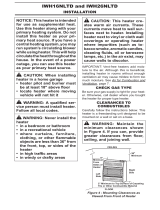
2 Installation instructions and Owner’s Manual
This appliance may be installed in an aftermarket* permanently manufactured (mobile) home, where not prohibited by
local codes.This appliance is only for use with the type of gas indicated on the rating plate. This appliance is not
convertible for use with any other gas.
*Aftermarket completion of sale, not for the purpose of resale, from the manufacturer.
2. Keep all air openings in heater clear, free of debris or
any blockage. This will insure that enough air for
proper combustion enters the heater.
3. If heater shuts off, do not relight until you provide
fresh, outside air. If heater keeps shutting off, it
requires servicing.
4. Turn off and unplug heater and let cool before servic-
ing. Only a qualified service person should service
and repair heater.
5. Do not run heater:
• Where flammable liquids or vapors are used or
stored
• During dusty conditions.
6. Before using furniture polish, wax, carpet cleaner or
similar products, turn heater off. If heated the vapors
from these products may create a white powder
residue within burner box or on adjacent walls or
furniture.
7. Do not use heater if any part has been underwater.
Immediately call a qualified service technician to
inspect the room heater and to replace any part of
the control system and any gas control which has
been underwater.
8. Operating heater above elevations of 4,500 feet could
cause pilot/ODS to shutdown heater.
9. Always run heater with control knob in a locked
position. Never set control knob between locked
positions. Poor combustion and higher levels of
carbon monoxide may result if control knob is left
between locked positions.
DANGER: Carbon monoxide poisoning may lead to
death.
Carbon Monoxide Poisoning:
Early signs of carbon monoxide poisoning resemble the
flu, with headaches, dizziness, or nausea. If you have
these signs, the heater may not be working properly.
Get fresh air at once! Have heater serviced. Some
people are more affected by carbon monoxide than
others. These include pregnant women, persons with
heart or lung disease or anemia, those under the
influence of alcohol, and those at high altitudes.
Propane/LP Gas:
Propoane/LP gas is odorless. An odor making agent is
added to propane/LP gas. The odor helps you detect a
Propane/LP gas leak. However the odor added to
propane/LP gas may be present even though no odor
exists. Make certain you read and understand all
warnings. Keep this manual for reference. It is your
guide to safe and proper operation of this heater.
WARNINGS
IMPORTANT: Read this owner’s manual carefully
and completely before trying to assemble, operate,
or service this heater. Improper use of this heater
can cause serious injury or death from burns, fire,
explosion, electrical shock, and carbon monoxide
poisoning.
WARNING: This appliance is equipped for (natural
or propane) gas. Field conversion is not permited.
WARNING: Do not use any accessory not ap-
proved for use with this heater.
WARNING: Any change to this heater or its controls
can be dangerous.
• Do not place clothing or other flammable
material on or near the appliance. Never
place any objects on the heater.
• Due to high temperatures, heater should be
kept out of traffic and away from furniture and
draperies.
• Surface of heater becomes very hot when
running. Keep children and adults away from
hot surfaces to avoid burns or clothing ignition.
Heater will remain hot for a time after shut-
down. Allow heater surfaces to cool before
handling.
• Young children should be carefully supervised
when they are in the same room with heater.
• Make sure grille guard is in place before
running heater. If screen or grille guard is
removed for servicing it must be replaced prior
to operating the heater.
• Keep the appliance area clear and free from
combustible materials, gasoline, and other
flammable vapors and liquids.
Every time hose or tank is connected to unit,
connection must be checked for leaks in one or
more ways: Apply soapy water to connection, look
for bubbles, listen for hiss of escaping gas, feel for
extreme cold, smell for rotten egg odor. Do not use
if leaking!
PRECAUTIONS:
WARNING:
1. This heater needs outside ventilation air to run
properly. The Oxygen Depletion Sensor (ODS)
safety shutoff system shuts down the heater if not
enough fresh air is available. See Fresh Air for
Combustion and Ventilation, page 3.



















